
The Aizoaceae, or fig-marigold family, is a large family of dicotyledonous flowering plants containing 135 genera and about 1800 species. They are commonly known as ice plants or carpet weeds. They are often called vygies in South Africa and New Zealand. Highly succulent species that resemble stones are sometimes called mesembs.

Frithia pulchra, the fairy elephant's feet, is a species of flowering plant in the fig‑marigold family Aizoaceae, endemic to Gauteng Province, South Africa. Its natural habitat is temperate grassland with high summer rainfall. A tiny stemless succulent growing to just 10 cm (3.9 in) tall and 20 cm (7.9 in) broad, it has bulbous oblong leaves with leaf windows at the tip; and magenta and white daisy-like flowers in winter. During periods of drought it has the ability to shrink beneath the soil surface, thus avoiding excessive desiccation, but making it extremely difficult to find.
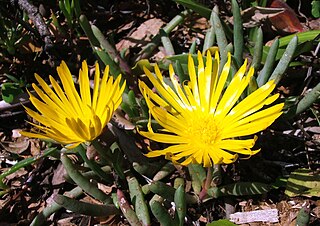
Jordaaniella dubia is a coastal succulent plant of the family Aizoaceae. It is indigenous to the Cape Provinces of South Africa, and is easy to propagate, making an attractive ground cover for coastal gardens.
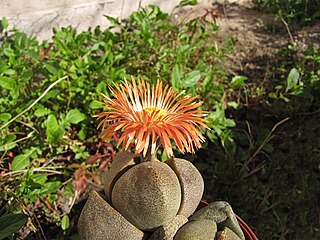
Pleiospilos nelii, the split rock, splitrock or living granite, is a species of flowering plant in the family Aizoaceae, native to South Africa. It grows in semi-arid areas with rainfall of between 150mm and 300mm, in the Karoo of South Africa.
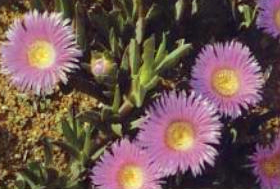
Carpobrotus muirii is a succulent perennial of the family Aizoaceae, native to the Overberg region in the Western Cape, South Africa.
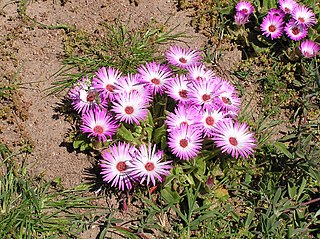
Cleretum bellidiforme, commonly called Livingstone daisy, Bokbaaivygie (Afrikaans), or Buck Bay vygie, is a species of flowering plant in the family Aizoaceae, native to the Cape Peninsula in South Africa. It is a low-growing succulent annual growing to 25 cm (10 in), and cultivated for its iridescent, many-petalled, daisy-like blooms in shades of white, yellow, orange, cream, pink and crimson. In temperate areas it is popularly grown as a half-hardy annual, and lends itself to mass plantings or as edging plants in summer bedding schemes in parks and gardens. It is still widely referenced under its former names, Mesembryanthemum criniflorum and Dorotheanthus bellidiformis.

Muiria hortenseae ("mouse-head") is a rare dwarf species of succulent plant of the family Aizoaceae, indigenous to a very small area in the Little Karoo, Western Cape, South Africa. It is the only species in the monophyletic genus Muiria.
Vlokia ater was the first species described for the genus Vlokia in the Aizoaceae plant family. The genus name honors the discoverer, South African botanist, Jan H. J. Vlok (1957-). The species name derives from the Latin adjective "ater" for "black" and refers to the black coloring which older leaf leaves assume.
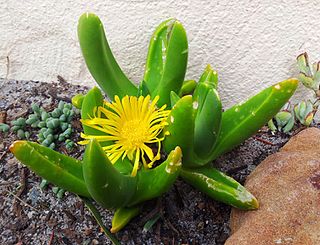
Glottiphyllum regium is a rare species of succulent plant, in the family Aizoaceae. It is known locally as "koeispene". It is restricted to a small arid area near Calitzdorp in the Western Cape, South Africa.

Lithops olivacea is a species of the genus Lithops under the family Aizoaceae. The name olivacea refers to the Latin word for olive (oliva) combined with the suffix -cea, meaning "of the likeness", producing the idea of "olive likeness". Lithops olivacea grow primarily in the Bushmandland of South Africa. They grow most abundantly in the regions of Aggeneys, Pofadder, and Namies. L. olivacea also received the Royal Horticultural Society's Award of Garden Merit for being "excellent for ordinary use in appropriate conditions, available to buy, of good constitution, essentially stable in form & colour, [and] reasonably resistant to pests & diseases."

Drosanthemum micans, is a succulent plant in the ice plant family, Aizoaceae, indigenous to the Robertson Karoo and Overberg regions of the Western Cape Province, South Africa.
Cephalophyllum diversiphyllum is a plant species in the family Aizoaceae, endemic to the Western Cape Province, South Africa.

Cephalophyllum purpureo-album is a plant species in the family Aizoaceae, endemic to the Western Cape Province, South Africa.

Cephalophyllum subulatoides is a plant species in the family Aizoaceae, endemic to the eastern parts of the Western Cape Province, South Africa.
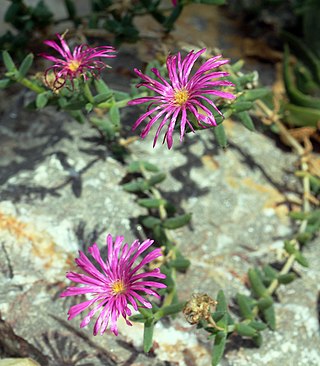
Trichodiadema barbatum is succulent plant of the genus Trichodiadema, native to the Eastern Cape Province, South Africa.
Didymaotus is a monotypic genus of flowering plant belonging to the family Aizoaceae, containing the single species Didymaotus lapidiformis. The plant is also known by the names stone plant and beeskloutjie. It occurs natively in the arid regions of Tanqua Karoo, near Ceres in the Western Cape. The generic name is taken from the Greek words didymos, meaning double, and aotus, meaning flower; the plant that bears two flowers. The specific epithet lapidiformis means stone-like, as it is not easily seen, blending in with its surroundings.
Mossia is a monotypic genus of flowering plants belonging to the family Aizoaceae. It only contains one known species, Mossia intervallaris.
Stayneria is a genus of flowering plants belonging to the family Aizoaceae. It contains a single species, Stayneria neilii. It is in the subfamily Ruschioideae and the tribe Ruschieae.

Argyroderma testiculare is a species of succulents endemic to the quartz gravel of the Knersvlakte region. of South Africa's Western Cape. It belongs to the Aizoaceae family, and is listed as rare on the SANBI Red List, because it occurs in an area smaller than 68 km2, but it is not endangered there.
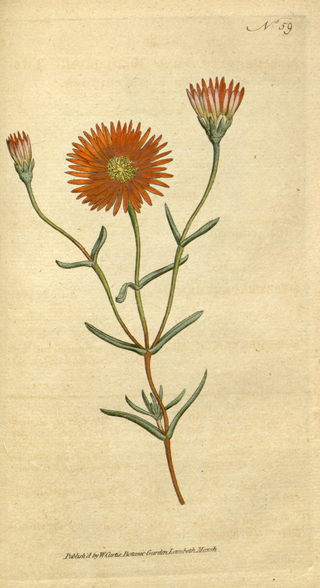
Lampranthus bicolor, the bicoloured lampranthus, is a species of flowering plant in the family Aizoaceae, native to the southwestern Cape Provinces of South Africa. A spreading succulent reaching 30 cm (12 in), it prefers to grow in sandy areas.















